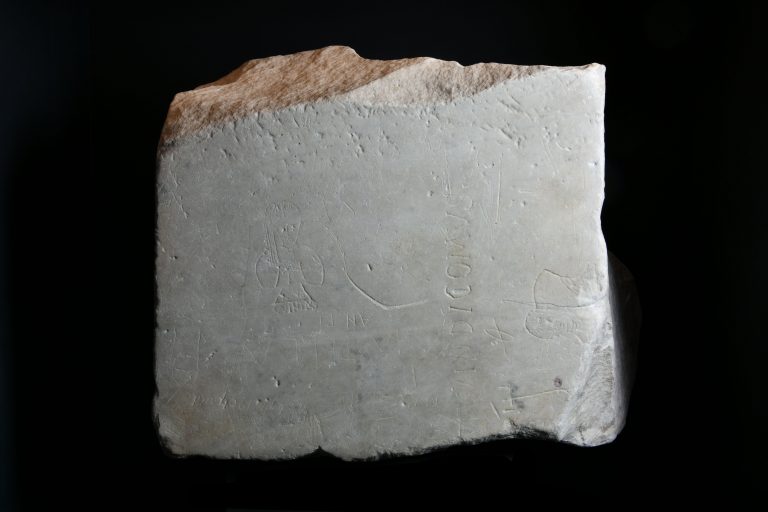Graffiti from the Amphitheater with scenes of gladiatorial combat
Most of the graffiti on display in the Colosseum Museum (on marble slabs or blocks) were carved into the marble cladding of the cavea stairways. They are therefore depictions of the games and their participants, made by the spectators waiting in the amphitheater between one show and the next.
Their subjects are in fact hunting scenes (venationes) and gladiatorial combat (munera); the crowd’s favorite combatants were usually identified by name (Vindicomus) or accompanied by cheers (e.g. Feliciter: Hurray!) or by symbols linked to the death of their opponents (the theta, the Greek character which is the first letter in the word Thanòn, death) or to their victory (crowns or palm fronds). The most commonly represented gladiators in the museum’s collection are the pairing of the retiarius (armed with a weighted net and trident) and the secutor (armed with a rectangular shield and a smooth, rounded helmet).
However, many more types of gladiators are known to us, distinguishable by their country of origin, chosen weaponry and combat techniques. Some elements of the gladiatorial costume were common throughout all categories: strips of cloth or hide that were wrapped around the legs (fasciae) underneath the greaves (ocreae); partial or total protection of the arms (manica), consisting of interwoven strips of hide that were sometimes equipped with metal blades and which could extend as far down the arm as the hand, weighing only 1 kg so as not to impede the gladiator’s movements; the subligaculum, a loincloth held in place by a thick leather belt (balteus). Each class of gladiator had its own arms and armor. In general, the chest was always exposed.
The gladiators’ equipment could weigh up to 20 kg: the weight of the helmet (galea) varied between 3 and 5 kg, the greaves up to 2 kg. Greaves protected just the front and a small amount of the sides of the legs and their height (ranging from shin guards to above the knee) depended on the type of gladiator and the size of his shield: the smaller the shield, the higher the greaves. The smallest shields weighed 1.5 kg while the largest could weigh up to 8 kg. The retiarius’s net was circular in shape with a diameter of 3 or 4 meters and a mesh size of 10 to 20 cm. Small lead weights hung from the edges of the net, giving it an overall weight of up to 3 kg. The gladiator’s sword (gladium) weighed from 1 to 1.3 kg.
The duels followed a precise sistem of rules, pitting well-armed, offensive combatants against well-armored, defensive combatants so as to guarantee equal opportunities to both parties. The gladiator never turned his back on his opponent: the prevalent fighting position for all categories was frontal, torso straight or slightly rotated towards the opponent, left leg forward and flexed, feet shoulder-width apart. The position allowed for a certain mobility and gave fighters the chance to land mighty blows while also parrying those of the opponent, and it was particularly favorable to gladiators armed with a large shield.






